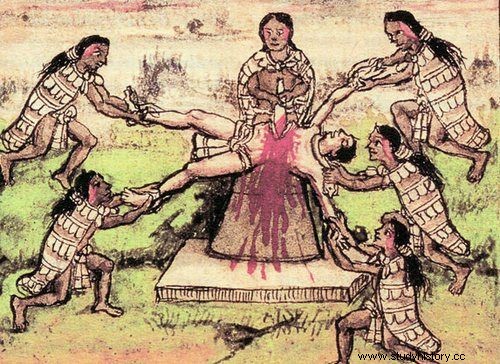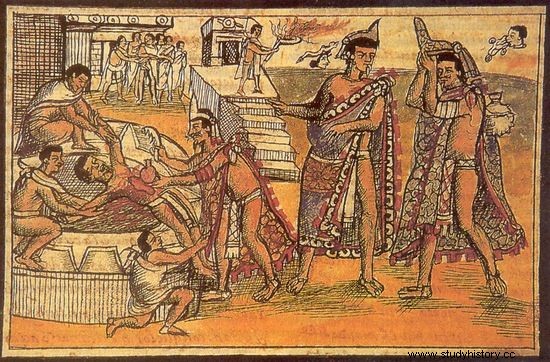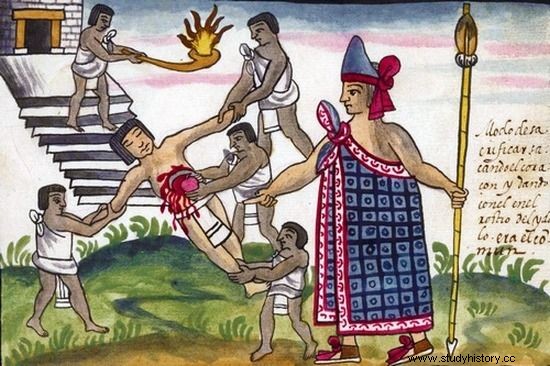The stripped and bound prisoner was thrown into the fire, where he roasted alive for a while. Then the priests took out the living victim and opened the chest with a knife to tear the still beating heart out of her chest. Description of an extremely sadistic execution? Too. But most of all, a typical rite of sacrifice in honor of the Aztec fire god Xihuatecuhtli.
The Aztecs don't have a very good press. Fact - they built an empire that stretched from the Gulf of Mexico to the Pacific coast, only to be ended by the arrival of the Spaniards. Usually, however, the cruelty of their rituals and the oppression of conquered nations are emphasized. Are these opinions exaggerated?
After all, human sacrifice in one form or another was characteristic of the whole of Mesoamerica, and the peoples inhabiting the empire often enjoyed the benefits of a peculiar Pax Aztec . A bit according to the rule - since we've already conquered you, now we'll leave you alone. But sometimes we sacrifice someone ... So let's take a look at some of the forms of giving back to the Aztec gods.
Did you get caught? You have a problem!
Prisoners of war were most often sacrificed. The unfortunates were led up the steps of the pyramid to the temple at its top. There they were placed on the altar. Four priests held the victim and another opened her chest with an obsidian knife and took out the heart, which might still beat for up to five minutes.

According to the Aztecs, the blood of their victims was to provide food for the Sun, which it needed to move through the sky.
The body was then thrown down the steps of the pyramid. Some of the victims' bodies were sometimes eaten, and it was considered an honor to invite them to such a feast . It is estimated that around 20,000 people were sacrificed annually across central Mexico.
This is how one of the conquistadors Bernal Diaz del Casstillo described it:
With a strike of a flint knife, they opened the chest of the unfortunate Indian and hurried to tear out a beating heart, which, together with the blood, they offered to the idol in whose name they performed this sacrifice. They cut off the arms, thighs, and head, eating thighs and arms at ceremonial feasts. They hung the head on a beam, and the body of the victim was not eaten, but given to animals for food.
The purpose of such rituals was to provide food for the Sun, which needed human blood to move through the sky. Such an Aztec way to fight the Apocalypse. It is worth noting, however, that the POWs intended to be sacrificed were respected.
Aztec religion envisioned a place for them next to the sun (but only for four years!) And then turning into a butterfly or hummingbird. The fate of the captured and sacrificed enemies was therefore the same as those of the warriors who fell on the battlefield.
They gave the flute, four wives, but then killed
Another form of sacrifice, not so massive, but stimulating the imagination, was the one in honor of Tezcatlipoka - the patron saint of war, discord, but also rulers. First, a young man with no physical blemishes was selected from among the prisoners. The candidate was then dressed in the Tezcatlipoka outfit. He was treated like a god for a year. He walked freely around the city in the company of eight pages, playing the flute .
Twenty days before the sacrifice, the young man received four wives representing the goddesses, who henceforth accompanied him on his journey. On Toxcal's Day, he would reach the foot of the temple at a time he chose.
Then he voluntarily climbed to the top, breaking flutes along the way. There the priests waited for him, who sacrificed him in the manner described earlier. As a token of exceptional respect, his body was not thrown down the stairs but endured by the priests.

Illustration from Diego Duran's gun titled Histoire des Indiens. Sacrifice Humain ”from 1579 showing a bloody ceremony. In this case, the victim is kept by only three priests, and the fourth is torn from her heart.
Unusual fertilizer for maize
Xipe Totec was the Aztec god of vegetation and ripening corn, which was the mainstay of the diet of all Mesoamerican people. No wonder, then, that the ritual in honor of this deity was characterized by an exceptional level of complexity.
First, a prisoner of war, who was brave on the battlefield, was tied to a round stone called temalacatl . He was armed with a club that had feathers attached instead of deadly obsidian blades .
His opponents were Aztec warriors in full armament. If the captive by some miracle managed to defeat four of them in succession, the fifth was left-handed, which made even the bravest ones succumb to him.
A defeated warrior was handed over to priests who would tear his heart out and tear off his skin. The victim's body was partially eaten, and selected men wore the skin for twenty days. They walked around the city, begging and then giving gifts to the poor. After those twenty days had elapsed, the skin was buried to ensure that the maize flourished.

Human sacrifice was necessary for the Aztecs. Only thanks to them it was possible to save the world from total destruction. They were also to ensure the favor of the gods responsible for everyday existence.
They wanted well…
Aztec rituals may seem barbaric. The victims were certainly not amused. It should be noted, however, that they were neither the first nor the only people to make human sacrifices in Mesoamerica. As we mentioned at the beginning, all the local communities liked these practices. One way or another. On a smaller or larger scale.
It is worth remembering one detail - the Aztecs did it in order to save the world from extinction or to provide a basis for existence . On the other hand, the admired (rightly, but for different reasons!), The Romans organized cruel games mainly to the delight of the public.
